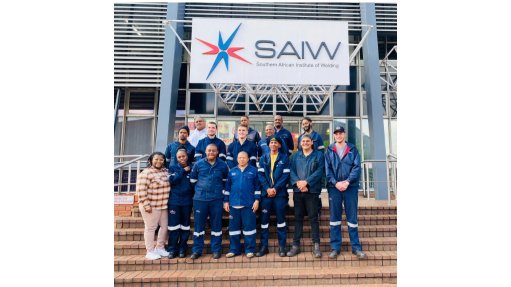
SUPPORTING LEARNERS The SAIW has evolved beyond its traditional role of certifying welders into a “full-spectrum career enabler” that supports learners from enrolment to global accreditation, including mentorship and continuous upskilling
While welding is “the backbone of infrastructure”, it has remained largely invisible to the public because it has been positioned as a support function rather than a driver of growth, says industry organisation the Southern African Institute of Welding (SAIW).
Therefore, as part of the organisation’s renewal, it is focused on repositioning welding as a national asset critical to localisation, industrialisation and infrastructure resilience, SAIW executive director Vicus Burger states.
“There’s a persistent view that welding is manual, dirty work best suited to those without academic potential. This is not only outdated; it’s harmful.”
This misconception, he argues, has prevented welding from being recognised as a strategic investment area, even though it underpins major industries such as manufacturing, energy and construction.
The SAIW is working to change this by creating a future-oriented vision of welding.
Central to this is a national campaign to reframe welding as a “high-tech, globally- relevant profession”.
“We’re placing welding at the heart of national development and industrial strategies,” says Burger, adding that the institute is actively engaging with government departments, State-owned enterprises and infrastructure planners to integrate welding capacity planning into early programme design.
Despite its critical role, welding has long been sidelined in national skills development efforts. Outdated curricula, fragmented training systems and underfunded institutions have contributed to a lag in local capacity.
The SAIW aims to address this by rolling out shared technology platforms and updated curricula aligned with pan-African benchmarks. These efforts, in turn, aim to close the skills gap while restoring South Africa’s regional competitiveness in welding and related fields.
Enabling Careers
The SAIW recognises the need for a more holistic approach to demonstrate how welding intersects with sovereign infrastructure goals, energy resilience, manufacturing value chains and youth employment.
Consequently, the organisation is evolving beyond its traditional role of certifying welders and is now a “full-spectrum career enabler”, supporting learners from enrolment to global accreditation. This support includes mentorship and continuous upskilling.
The institute is also introducing AI-driven assessment tools and real-time analytics to streamline its accreditation processes, improve quality control and accelerate trainees’ progression along training pathways.
Moreover, the SAIW is piloting regional welding hubs – centres that co-locate training, certification, employer engagement and innovation.
These hubs form “shared ecosystems” where public- and private-sector stakeholders co- invest in talent development, ensuring that the skills pipeline is “responsive, relevant and future-focused”.
This will be underpinned by smart platforms that automate administrative processes and ensure secure, efficient assessments.
The broader use of technology is not to be regarded as a threat, but as a democratising force, says Burger.
By equipping welders with AI-guided simulators, digital inspection tools and blended learning platforms, the institute is elevating the quality of work while expanding the scope of what welders can do.
“We’re not replacing welders – we’re amplifying their skills,” he emphasises.
Further, with over seven decades of experience, the organisation is positioning itself as the continent’s anchor institution for welding.
Its strategy includes regional capacity building, shared certification systems, harmonised standards and exportable curricula, all of which are designed to produce certified welders and globally competitive welding innovators.
Burger concludes that “SAIW 2.0 is about moving from legacy to leadership—shaping a smarter, more connected future for welding in South Africa and beyond”. ![]()